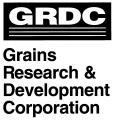wheat
Climate change and diseases of food crops
| Publication Type | Journal Article | |
| Year of Publication | 2011 | |
| Authors | Luck, J.; Spackman, M.; Freeman, A.; Trebicki, P.; Griffiths, W.; Finlay, K.; Chakraborty, S. | |
| Journal Title | Plant Pathology | |
| Volume | 60 | |
| Issue | 1 | |
| Pages | 113-121 |
Enhancing the detection of Tilletia indica, the cause of Karnal bunt - Final Report
| Publication Type | Report | |
| Year of Publication | 2009 | |
| Authors | Tan, M.; Wright, D. | |
| Prepared for | Cooperative Research Centre for National Plant Biosecurity | |
| Pages | 63 | |
| Date | 06/2009 | |
| Institution | NSW Industry & Investment |
Production and fitness of Fusarium pseudograminearum inoculum at elevated carbon dioxide in FACE
| Publication Type | Journal Article | |
| Year of Publication | 2010 | |
| Authors | MELLOY, P.; HOLLAWAY, G.; LUCK, J.; NORTON, R.; AITKEN, E.; CHAKRABORTY, S. | |
| Journal Title | Global Change Biology |
Planning for the worst
| Publication Type | Magazine Article | |
| Year of Publication | 2008 | |
| Authors | Taylor, S. | |
| Magazine Name | GRDC Ground Cover Grain Hygiene Supplement | |
| Issue | 76 | |
| Publisher | Grains Research and Development Corporation | |
| Notes |
The emergnece of strong resistance
| Publication Type | Magazine Article | |
| Year of Publication | 2008 | |
| Authors | Collins, P. | |
| Magazine Name | GRDC Ground Cover Grain Hygiene Supplement | |
| Issue | 76 | |
| Publisher | Grains Research and Development Corporation |
Wheat stripe rust (Puccinia striiformis f. sp. tritici (Pst)) is listed as a bioterrorism threat to U.S. agriculture in the Bioterrorism Preparedness and Response Act of 2002 and was even developed, along with wheat leaf rust, by the USSR as a bio-warfare weapon (Bruce, Fink, & Lander, 2003). Wheat stripe rust is an important disease in all wheat growing regions of temperate-cold climates. It has been reported in over 60 countries (Chen, 2005) and is the second most important disease of wheat in Australia, causing an estimated $127 million in losses annually. Barley grass stripe rust (Psp-h), Cocksfoot stripe rust (Psd) and Kentucky Bluegrass Stripe Rust (Psp) are also present in Australia.
Variation in Pst in Australia has been largely observed in rust surveys based on host disease response with limited molecular studies. Simple Sequence Repeats (SSRs), also known as microsatellites, have shown some potential to reveal more information than other molecular markers in studies of Pst (Keiper et al., 2003, Spackman et al. 2010, Zhan et al. 2012). The range of SSR markers described to date ( Enjalbert et al., 2002, Bahri et al., 2009, Chen et al., 2009) have been of some value in illustrating contrasts between geographically separated Pst populations. However there is a need to develop a greater range of polymorphic SSRs that enable an expansion in studies between and within the variants of P. striiformis, including formae specilaes and pathotypes. The recent publication of the Pst genome (Cantu et al., 2011) provides an opportunity to develop an expanded range of SSR markers and to screen these on Australian isolates of P. striiformis. The development of a new suite of SSRs would have the potential to reveal insights into the evolutionary history of Pst within Australia as well as the mechanisms underlying pathogenic variability detected in the Pst population.
What is the biosecurity problem?
Rapid identification of unknown Puccinia striiformis. The known incursion events in Australia, and worldwide, demonstrate the ease with which pathogens, and new pathotypes, can be introduced into agroecosystems. Even with improved quarantine and biosecurity measures there is still the risk that further incursions may occur. With host boundaries between formae speciales of Puccinia striiformis being somewhat blurred and Barley Stripe Rust being considered a high risk pathogen to Australia (Spackman et al. 2010), a molecular based identification protocol would be very valuable.
The outputs of this project are to:
- Develop a diagnostic protocol for the rapid identification of potential foreign rust pathogens.
- Conduct a comprehensive analysis of molecular features of the Pst population in Australia.
- Assess the relationship between Pst and wild barley grass species. Wild barley grass identified as an ancillary host to Pst as well as the principal host of Psp-h .
STUDENT
PROJECT DETAILS
Active
Supervisor
Dr Colin Wellings (Plant Breeding Institute)
Supervising Institution
The University of Sydney
Term
July 2009 - July 2012
LOCATION
2009 Grains Industry Forum
Like all other sectors the grains industry is battling to come to terms with a world, seemingly, in a constant state of change, offering new challenges - but also new opportunities.
I recently attended the 2009 Grains Industry Leaders Summit where industry representatives highlighted the need to work together to gain resolutions for a more sustainable future. The summit was organised by the Grains Council of Australia (GCA), and was held in Sydney on 31 March with more than 90 attendees present. The summit focused on three critical issues:
This project will improve the level of preparedness for, and the sustainable resistance to, the Russian wheat aphid. it will also assist Australia's grain industry to remain free of Russian wheat aphids.
What is the biosecurity problem?
Russian wheat aphid has invaded all major wheat growing regions of the world except Australia. To ensure that Australia's breeding strategy has the capacity to provide resistant wheat lines, it is necessary to understand the mechanisms underlying virulence.
The main output of this project is to:
- improve level of preparedness for Russian wheat aphid incursions into Australia, and
- develop a strategy for Australian wheat breeders to achieve sustainable and stable resistance to Russian wheat aphid, reducing the need for insecticides.
Who will be the end-users of this research?
The project will determine what level of risk is posed by genetic changes in the Russian wheat aphid. Results will be discussed with the Australian grains industry. The focus with industry will be to help create an understanding of the risk posed by the Russian wheat aphid, particularly in relation to their breeding program. This will benefit the wheat industry's level of preparedness and ensure that its principal strategy of resistant varieties remains viable.
PROJECT LEADER

Dr Owain Edwards
Project Leader CRC40006: Russian Wheat Aphid
Owain.Edwards@csiro.au
Phone: 08 9333 6401
Fax: 08 9333 6646
Read More
PROJECT DETAILS
Active
Term
August 2006 - September 2012
Budget
$373,800 (cash and in-kind support)





